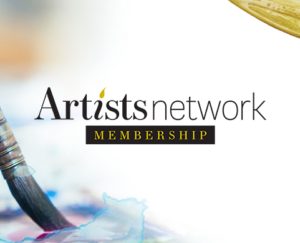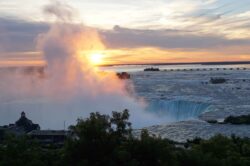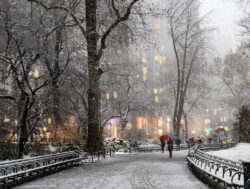Into the Woods With Pastel and Graphite

Artists have employed a combination of chalk or pastel with graphite for line drawings on toned paper for centuries. Learn how to use the technique to deliver striking dimension and add color to forest scenes.
by Debby Kaspari

In 2008, my husband and I made a plan to live in a forest in Massachusetts for six months. Among other things, I saw it as a perfect chance to focus on a mixed-media approach I’d been playing with: combining pastel and graphite.
When we arrived at our forest home in early spring, snow still clung in patches under the bare trees, but I immediately set out on a hike and started drawing. Since then, I’ve used this technique for drawing in tropical Panama, in the Amazon rainforest and among Oregon’s old-growth giant firs. It’s a wonderful method for portraying the intricate patterns of forest interiors.
Related: See a demo of Debbi’s plein air setup and technique
Member Exclusive
Artists Network members had an exclusive opportunity to attend a live virtual artists talk and demonstration with Debby. Log into your membership to view the playback here!
The Technique
I use graphite and pastel en plein air, but the technique can be equally effective in the studio, and you don’t need a lot of pastels; a handful can provide plenty of values and a good range of color. The paper sets the middle tone and unifies the piece while the graphite delivers volume, shadows and darks.


1: Start with Graphite Outlines.
Working on a sheet of lightly toothed, toned paper, begin by establishing outlines, shaded areas and darks, using a soft graphite pencil. Draw with loosely scribbled, scumbled or crosshatched lines, reserving open spaces for pastel touches in some places and allowing for the tone of the paper to show through in others. Remember, the graphite creates your darkest value.

2: Add Pastel.
Smudge, blend, push and pull, but avoid layering over the graphite’s slick surface, as it repels pastel. Be sure to use pastels that are lighter in value than the graphite. Experiment. Play with papers in various mid-tones, colors and textures.

3: Set the Scene.
Work with your materials to set the scene. If it’s a shady forestscape, darker paper gives instant depth and brighter highlights. Warm tan paper resonates with cool pastels. Cool gray paper comes alive with warm terra cottas, yellows and greens. In this technique, paper is your middle value, graphite is your structure and darkest dark, and pastel brings color and value—plus some zest—to the picture.

The Materials
Papers
I use a variety of papers: Rives BFK, in tan or gray; Hahnemuhle Ingres; Canson Mi-Tientes and Fabriano Tiziano—all of which hold pastel well but aren’t so toothy that pencils can’t make clean lines. The paper’s color and tone establish the key and unite the composition. Avoid white paper, which is too pale, and sanded paper, which wears down pencils.

Pencils
Soft, dark Nos. 4B through 9B pencils, graphite bars or leads in lead holders work best. My favorite is the Koh-I-Noor Hardtmuth Triograph No. 6B. It’s a terrific pencil, but it doesn’t fit in most two-hole pencil sharpeners and, therefore, requires an extra-large diameter sharpener. Some artists sharpen it with a knife, but I’ve discovered that drugstore eyeliner and lip-liner sharpeners work great. Go to the makeup counter with a Triograph and check for the best fit. If you need to erase, do so gently with a kneaded eraser. Some of these papers don’t tolerate heavy erasing.
Pastels
Hard to medium-soft pastels work best. Nupastels, Faber-Castell Goldfaber Studio pastel sticks and Holbein pastels are my favorites. Very soft pastels should be used sparingly as they tend to overfill the paper’s tooth. You’ll need both light and medium values, a few grays and some saturated brights. Don’t use pastels that are any darker in value than the graphite. I prefer muted colors for nature scenes: yellow ochres, warm and cool grays, rusts, pale turquoises, yellow and blue-greens, creams, mauves, ultramarine, light cobalt blue, dusty rose, white, and light and mid-value browns. I use pieces of pastel that are about 1-inch long or shorter, turned sideways, for nice, wide strokes.
Equipment
When making large plein air drawings, using a wood or Masonite board will provide strong backing. Use a sturdy easel that angles back or flat, such as a French box easel or Jullian Rexy watercolor easel. If you’re working smaller, a drawing board on your lap and a folding chair will suffice.
Keep your loose paper in a folio with glassine sheets that you can place in between finished drawings. I carry my materials in a portfolio tote bag. A small backpack can hold your pencils, pastels, masking tape, binder clips, a small sketchbook for thumbnails and, if you like, something on which to rest your hand to prevent smudging. I use a clean peanut butter jar lid. A plein air umbrella is optional, but can be handy for diffusing patchy light under trees.
Dos and Don’ts
- Don’t layer pastel on top of graphite (but you can draw graphite on top of pastel).
- Do leave gaps in the drawing for added color and highlights.
- Don’t use papers or pastels that are darker than your darkest graphite value.
- Do leave some paper showing through; its tone and color unifies the picture.
About the Artist
Debby Kaspari explores the natural world with pencil and paper. When not working directly from nature, she can be found drawing from high atop a one-story bungalow in the middle of Oklahoma.
This article contains affiliate links that help us earn a small commission from purchases — at no additional cost to you. We are grateful for your support.
More Resources from Debby Kaspari
How to Draw Birds: 8 Techniques and Tips
5 Ink Drawing Techniques for Plein Air
Fearless Fieldwork: A Live Discussion and Demo for Artists Network Members
 Artists Network Membership - 1 Year
Artists Network Membership - 1 Year  Breakthrough Paint Along: Where Mixed Media Combine Together
Breakthrough Paint Along: Where Mixed Media Combine Together  Paint Along 127: Paint the Motion of the Sea
Paint Along 127: Paint the Motion of the Sea  Paint Along 126: Simplify Your Landscapes with a Limited Palette
Paint Along 126: Simplify Your Landscapes with a Limited Palette  Breakthrough Paint Along: The Big Value of Miniature Landscapes
Breakthrough Paint Along: The Big Value of Miniature Landscapes  Portrait Painting: Rembrandt's Techniques Video Download
Portrait Painting: Rembrandt's Techniques Video Download  Figure Drawing Tips with Brent Eviston Video Download
Figure Drawing Tips with Brent Eviston Video Download  Southwest Art August/September 2025 Digital Edition
Southwest Art August/September 2025 Digital Edition  Artists Magazine July/August 2025 Digital Edition
Artists Magazine July/August 2025 Digital Edition  Pastel Journal Summer 2025 Digital Edition
Pastel Journal Summer 2025 Digital Edition  Artists Magazine March/April 2025 Digital Edition
Artists Magazine March/April 2025 Digital Edition  Artists Magazine January/February 2025 Digital Edition
Artists Magazine January/February 2025 Digital Edition  Best of Watercolor: Winners of the Splash 26 Competition Print Edition
Best of Watercolor: Winners of the Splash 26 Competition Print Edition  Southwest Art June/July 2025 Print Edition
Southwest Art June/July 2025 Print Edition  Artists Magazine May/June 2025 Print Edition
Artists Magazine May/June 2025 Print Edition  Southwest Art 2021 Digital Collection × 1
Southwest Art 2021 Digital Collection × 1  Watercolor Artist 2020 Digital Collection × 1
Watercolor Artist 2020 Digital Collection × 1  Watercolor Artist 2019 Annual Digital Collection × 1
Watercolor Artist 2019 Annual Digital Collection × 1  Watercolor Mega Magazine Collection × 1
Watercolor Mega Magazine Collection × 1  Pastel for Beginners Workshop
Pastel for Beginners Workshop  Composition & Design for Landscape Painting Video Workbook
Composition & Design for Landscape Painting Video Workbook  Drawing Mastery: Shading Course
Drawing Mastery: Shading Course  Alla Prima Bootcamp: 4 Weeks to Confident Painting Course
Alla Prima Bootcamp: 4 Weeks to Confident Painting Course  Eight Greats: The Pastel Journal's 10th Anniversary Artist Interview Series Digital Download
Eight Greats: The Pastel Journal's 10th Anniversary Artist Interview Series Digital Download  Secrets of Hyperrealist Watercolor Course
Secrets of Hyperrealist Watercolor Course  Acrylic Artist Summer 2017 Digital Edition
Acrylic Artist Summer 2017 Digital Edition  Exploring Acrylic: Abstract Art in Action Video Download
Exploring Acrylic: Abstract Art in Action Video Download  WetCanvas Live! Paint Stunning Landscapes from Photos: Lesson 23 & 24 Video Download
WetCanvas Live! Paint Stunning Landscapes from Photos: Lesson 23 & 24 Video Download  WetCanvas Live! Paint Stunning Landscapes from Photos: Lesson 9 & 10 Video Download
WetCanvas Live! Paint Stunning Landscapes from Photos: Lesson 9 & 10 Video Download  The Whimsical Face with Jane Davenport Video Download
The Whimsical Face with Jane Davenport Video Download 















Join the Conversation!